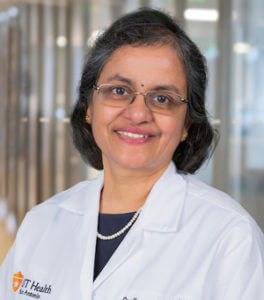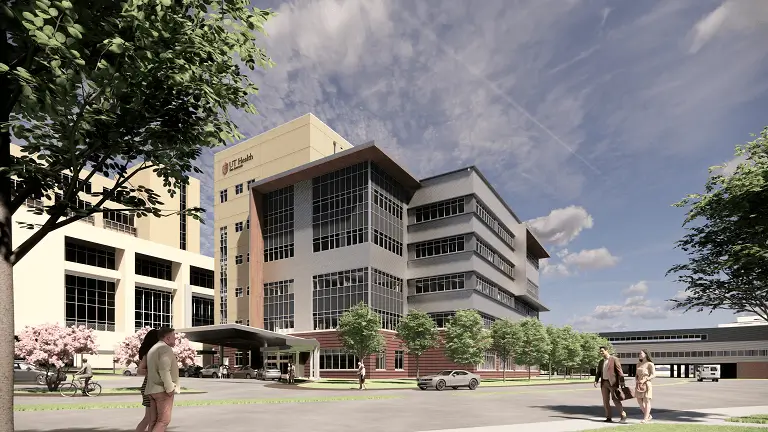Transformational facility set to open in December
Contact: Steven Lee, (210) 450-3823, lees22@uthscsa.edu
Content by Claire Kowalick
SAN ANTONIO, July 22, 2025 – The University of Texas Health Science Center at San Antonio’s (UT Health San Antonio) new Center for Brain Health will be a transformational facility bringing clinical care, innovative research and caregiver support together under one roof to revolutionize how diseases of the brain are treated and understood.
Scheduled to open in December at the intersection of Floyd Curl and Charles Katz drives, the $100 million, 103,000-square-foot center is designed to provide a comprehensive and hopeful experience for individuals facing neurological diseases, while advancing the science behind diagnosis and treatment.

Today, on World Brain Day, established by the World Federation of Neurology, leaders provide a preview of what’s in store. They note that the idea for the center began more than seven years ago, sparked by a vision to create a dedicated space for Alzheimer’s, dementia and other neurodegenerative disease care and research. That vision resonated across the San Antonio community, prompting more than $40 million in philanthropic support to help make this dream a reality.
“This center is the culmination of years of effort to build a space that not only meets the care needs of patients and families, but also expands our research capacity,” said Sudha Seshadri, MD, DM, neurology professor and founding director of the Glenn Biggs Institute for Alzheimer’s and Neurodegenerative Diseases at UT Health San Antonio. “It’s deeply meaningful to me, both personally and professionally, to offer not just treatment, but respect for each person’s uniqueness. A diagnosis doesn’t define a person, and it certainly doesn’t stop their story.”
The Center for Brain Health, which will be home to the Biggs Institute, aims to redefine the treatment of conditions like Alzheimer’s, dementia, stroke, amyotrophic lateral sclerosis (ALS) and Parkinson’s with multidisciplinary care teams that include neurologists, therapists, counselors and support staff in one convenient location, reducing the need for multiple appointments and disjointed services. The center will feature 75 exam rooms, 12 infusion chairs for newly approved and investigational treatments, and specialty spaces for therapy, diagnostics and wellness.

The center will also house Texas’ first 7-Tesla Terra.X magnetic resonance imaging (MRI) scanner – one of the most powerful imaging technologies available – which provides ultra-high-resolution brain scans to guide early diagnosis and novel research.
“My hope is that we can make Alzheimer’s a condition people live with and manage – like diabetes or high blood pressure,” said Seshadri. “That’s the kind of hope we’re working to bring to every patient.”
Other services will include geriatric psychiatry, nutrition, neuropsychology, genetic counseling, physical therapy and mental health support for both patients and caregivers. Community spaces will host support groups and educational events.
“This is going to be more than a building; it’s a new model for neurological care,” said Carlayne Jackson, MD, FAAN, chair of the Department of Neurology. “Our patients need comprehensive assessments, imaging, neuropsychology testing, family services and more. All of that will be available here in a single, coordinated location.”

The center includes a pedestrian bridge to the Medical Arts and Research Center (MARC), is near the new UT Health San Antonio Multispecialty and Research Hospital and is across the street from the Sam and Ann Barshop Institute for Longevity and Aging Studies, enhancing collaboration across research and clinical care teams.
It is designed by Alamo Architects Inc. and TreanorHL, and is being constructed by Joeris General Contractors.
“The Center for Brain Health represents hope – a place where care and discovery come together to preserve brain health, ensure early diagnosis and help people keep doing what they love for as long as possible,” Seshadri said. “In a year’s time, I hope people will wonder how we ever managed without a place like this in San Antonio.”
Listen to additional remarks from Seshadri here in a special video that also features a construction time lapse of the Center for Brain Health at UT Health San Antonio. Today also marks the unveiling of the center’s new website, here.
World Brain Day is an annual observance dedicated to raising awareness about brain health and neurological disorders. It aims to promote neurological education, training and research, with a focus on under-resourced areas of the world. The 2025 theme is “Brain Health for All Ages,” emphasizing the importance of brain health across the entire lifespan.
The University of Texas Health Science Center at San Antonio (UT Health San Antonio) is one of the country’s leading health science and research universities. With missions of teaching, research and patient care, its schools of medicine, nursing, dentistry, health professions, graduate biomedical sciences and public health have graduated more than 45,000 alumni who are leading change, advancing their fields and renewing hope for patients and their families throughout South Texas and the world. To learn about the many ways “We make lives better®,” visit UTHealthSA.org.
Stay connected with UT Health San Antonio on Facebook, Twitter, LinkedIn, Instagram and YouTube.
The Glenn Biggs Institute for Alzheimer’s and Neurodegenerative Diseases is dedicated to providing comprehensive dementia care while advancing treatment through clinical trials and research. The Biggs Institute is a National Institute on Aging (NIA)-designated Alzheimer’s Disease Research Center (ADRC). In addition to patient care and research, the Biggs Institute partners with the School of Nursing at UT Health Science Center San Antonio to offer the Caring for the Caregiver program.


